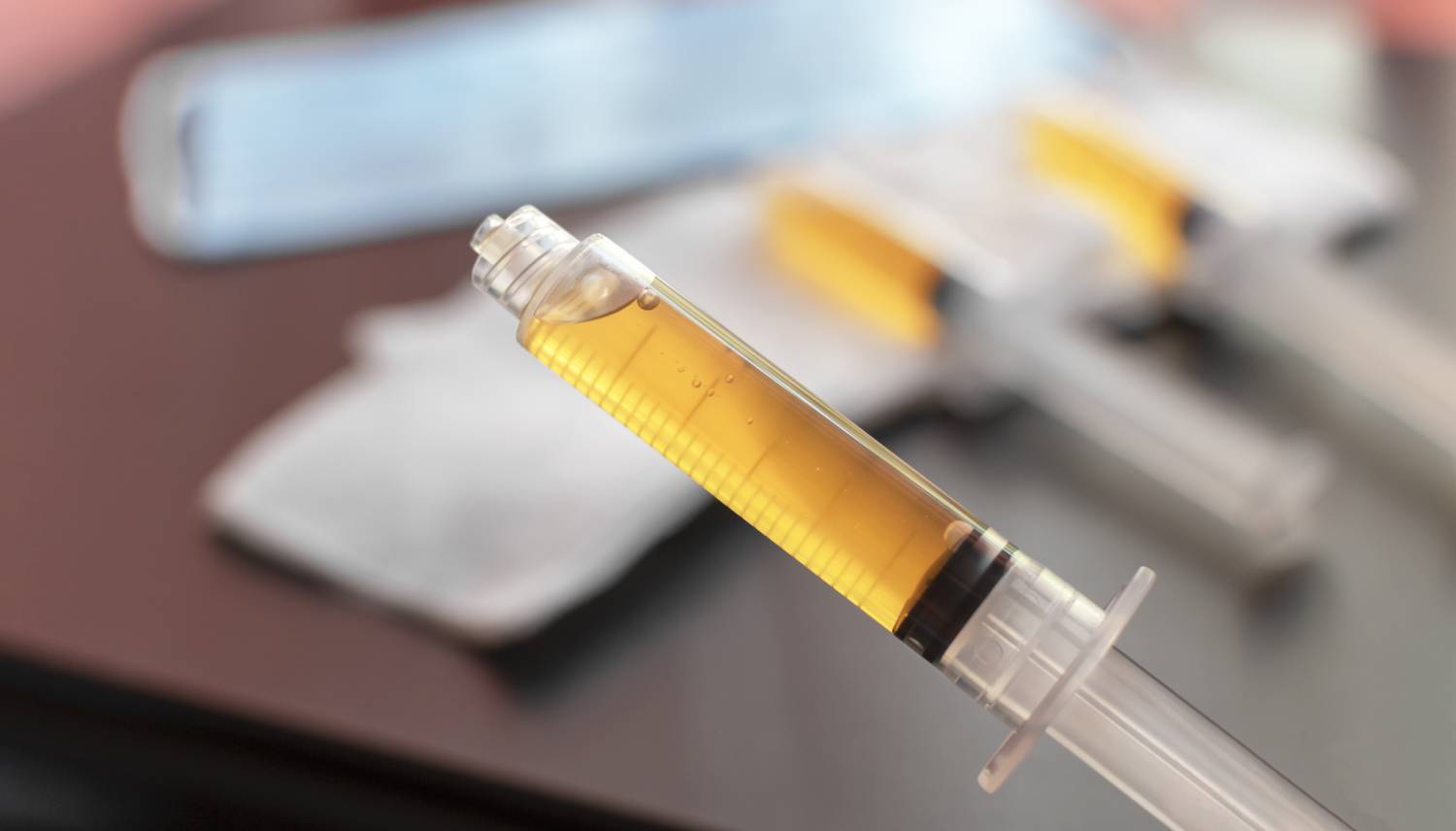Platelet-rich plasma, or PRP, is a general term referring to a variety of treatments in which a patient’s blood is reinjected into their body to treat damaged tissues [1]. PRP products may differ from one another according to white blood cell count, activation method, and platelet concentration [1]. This type of treatment can replace more traditional intraarticular products, including hyaluronic acid and corticosteroids [2]. However, conflicting reports concerning PRP’s effects on the duration and quality of patient recovery warrant a closer look into its ability to treat knee pain.
PRP’s ability to treat damaged tissues comes from the presence of growth factors and proteins in the platelets’ alpha granules [2, 3]. The proteins and growth factors balance angiogenesis and modulate anti-inflammatory signals [1]. Because PRP is an autologous treatment, patients do not run the risk of being infected by the diseases associated with blood transmission [4]. Consequently, PRP is considered a relatively low-cost and safe way for patients to acquire the necessary growth factors required to reduce or eliminate their pain [2].
Several studies found PRP to be an effective treatment for knee pain. A 2018 study split 25 knee osteoarthritis (OA) patients into two groups: one served as the control, receiving therapeutic exercises and acetaminophen, while the other received two intra-articular PRP injections six weeks apart [1]. The researchers followed up with these patients at regular time intervals [1]. At each follow-up, the PRP group reported significantly better improvement according to the Western Ontario and McMaster Universities Osteoarthritis index (WOMAC) [1].
A prospective analysis of 15 patients suffering from knee pain found that patients reported considerable improvement three months after receiving PRP injections according to the Tegner Lysholm Knee Scoring Scale (TLKSS) [3]. The difference between TLKSS values three months and six months following PRP injection was not statistically significant [3]. These findings suggest that PRP injections may be effective in short-term knee pain reduction [3].
Dong et al. reported a similar result. By meta-analyzing 24 randomly controlled trials (21 of which followed knee OA patients), the researchers found that WOMAC pain, physical function, and stiffness were better in the PRP group than the control group over the short term (0 months to 12 months following injection) [4]. Over the long term (18+ months), PRP patients did not fare any better than control patients [4]. Because control groups may have received hyaluronic acid (HA), normal saline, prolotherapy, or acetaminophen, this meta-analysis is limited in its ability to conclusively compare PRP to any specific treatment [4].
Fortunately, various studies have compared PRP injections to other intraarticular knee pain treatments. Di Martino et al. conducted a randomized, controlled trial to test the efficacy of PRP compared to HA in treating knee degenerative disease. 192 patients received three weekly inter-articular injections of either substance and were evaluated four times following injection [5]. At each time interval, PRP was just as effective as HA, with the only difference being that PRP patients exhibited lower rates of reintervention at 24 months [5]. A large meta-study by Filardo et al. found that PRP treatment was no more effective than placebo at six months and HA at one month [2]. Over time, PRP grew to reduce patients’ pain more than the other treatments according to the WOMAC scale [2].
Because of the contradictory nature of these findings, it is unknown whether PRP is more effective than other treatments. Regardless, the aforementioned results suggest that PRP is at least as effective as other intraarticular knee pain products, in addition to being low risk.
References
[1] M. Ranade, H. Pandit, and K. Kothari, “Does intraarticular PRP injection improve function, pain and quality of life in patients with OA of knee? Case control study of 50 patients,” Journal of Arthroscopy and Joint Surgery, vol. 5, no. 3, p. 171-174, January 2018. [Online]. Available: https://doi.org/10.1016/j/jajs.2018.06.001.
[2] G. Filardo et al., “PRP Injections for the Treatment of Knee Osteoarthritis: A Meta-Analysis of Randomized Controlled Trials,” Cartilage, p. 1-12, June 2020. [Online]. Available: https://doi.org/10.1177/1947603520931170.
[3] K. Mitev and A. Longurov, “Intra-articular Platelet-Rich Plasma Injections for Treating Knee Pain Associated with Articular Cartilage and Degenerative Meniscal Lesions,” Open Access Macedonian Journal of Medical Sciences, vol. 7, no. 15, p. 2484-2487, August 2019. [Online]. Available: https://doi.org/10.3889/oamjms.2019.674.
[4] Y. Dong et al., “The effects of platelet-rich plasma injection in knee and hip osteoarthritis: a meta-analysis of randomized controlled trials,” Clinical Rheumatology, vol. 40, p. 263-277, June 2020. [Online]. Available: https://doi.org/10.1007/s10067-020-05185-2.
[5] A. Di Martino et al., “Platelet-Rich Plasma Versus Hyaluronic Acid Injections for the Treatment of Knee Osteoarthritis: Results at 5 Years of a Double-Blind, Randomized Controlled Trial,” American Journal of Sports Medicine, vol. 47, no. 2, p. 347-354, December 2018. [Online]. Available: https://doi.org/10.1177/0363546518814532.
